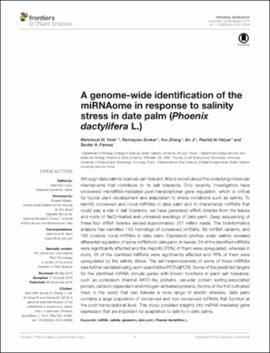| dc.contributor.author | Yaish, Mahmoud W. | |
| dc.contributor.author | Sunkar, Ramanjulu | |
| dc.contributor.author | Zheng, Yun | |
| dc.contributor.author | Ji, Bo | |
| dc.contributor.author | Al-Yahyai, Rashid | |
| dc.contributor.author | Farooq, Sardar A. | |
| dc.date.accessioned | 2019-09-25T18:24:44Z | |
| dc.date.available | 2019-09-25T18:24:44Z | |
| dc.date.issued | 2015-11-05 | |
| dc.identifier | oksd_yaish_identificationo_2015-11-08 | |
| dc.identifier.citation | Yaish, M. W., Sunkar, R., Zheng, Y., Ji, B., Al-Yahyai, R., & Farooq, S. A. (2015). A genome-wide identification of the miRNAome in response to salinity stress in date palm (Phoenix dactylifera L.). Frontiers in Plant Science, 6. https://doi.org/10.3389/fpls.2015.00946 | |
| dc.identifier.uri | https://hdl.handle.net/11244/321445 | |
| dc.description.abstract | Although date palm is relatively salt-tolerant, little is known about the underlying molecular mechanisms that contribute to its salt tolerance. Only recently, investigators have uncovered microRNA-mediated post-transcriptional gene regulation, which is critical for typical plant development and adaptation to stress conditions such as salinity. To identify conserved and novel miRNAs in date palm and to characterize miRNAs that could play a role in salt tolerance, we have generated sRNA libraries from the leaves and roots of NaCl-treated and untreated seedlings of date palm. Deep sequencing of these four sRNA libraries yielded approximately 251 million reads. The bioinformatics analysis has identified 153 homologs of conserved miRNAs, 89 miRNA variants, and 180 putative novel miRNAs in date palm. Expression profiles under salinity revealed differential regulation of some miRNAs in date palm. In leaves, 54 of the identified miRNAs were significantly affected and the majority (70%) of them were upregulated, whereas in roots, 25 of the identified miRNAs were significantly affected and 76% of them were upregulated by the salinity stress. The salt-responsiveness of some of these miRNAs was further validated using semi-quantitative PCR (qPCR). Some of the predicted targets for the identified miRNA include genes with known functions in plant salt tolerance, such as potassium channel AKT2-like proteins, vacuolar protein sorting-associated protein, calcium-dependent and mitogen-activated proteins. As one of the first cultivated trees in the world that can tolerate a wide range of abiotic stresses, date palm contains a large population of conserved and non-conserved miRNAs that function at the post-transcriptional level. This study provided insights into miRNA-mediated gene expression that are important for adaptation to salinity in date palms. | |
| dc.format | application/pdf | |
| dc.language | en_US | |
| dc.publisher | Frontiers Media | |
| dc.rights | This material has been previously published. In the Oklahoma State University Library's institutional repository this version is made available through the open access principles and the terms of agreement/consent between the author(s) and the publisher. The permission policy on the use, reproduction or distribution of the material falls under fair use for educational, scholarship, and research purposes. Contact Digital Resources and Discovery Services at lib-dls@okstate.edu or 405-744-9161 for further information. | |
| dc.title | Genome-wide identification of the miRNAome in response to salinity stress in date palm (Phoenix dactylifera L.) | |
| osu.filename | oksd_yaish_identificationo_2015-11-08.pdf | |
| dc.description.peerreview | Peer reviewed | |
| dc.identifier.doi | 10.3389/fpls.2015.00946 | |
| dc.description.department | Biochemistry and Molecular Biology | |
| dc.type.genre | Article | |
| dc.type.material | Text | |
| dc.subject.keywords | genomics | |
| dc.subject.keywords | mirna | |
| dc.subject.keywords | salinity | |
| dc.subject.keywords | date palm | |
| dc.subject.keywords | phoenix dactylifera l. | |
